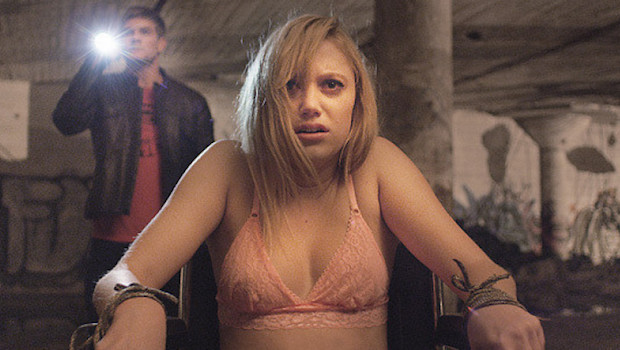4 cheap tricks horror movies use to scare you
The hidden techniques horror movie directors use to terrify their audience

I'm sure you're all thinking that the best horror movies scare you because they make you jump. Or that they show people's inside parts on the outside, and so on. But there's more to it that a loud 'BOO!' and some well placed blood and guts. The art of a good scare is a skill, which is why the same names - George Romero, James Wan, John Carpenter, Mike Flanagan and so on - often pop up.
Directors use pacing, camera angles, sound and more to manipulate you into being scared, often without you even realising you're being played. Well crafted set ups can make a pay off so much more than gore and noise. It's one of the reasons remakes of classics can often fall flat - same monsters, same ideas, less scares.
A good horror movie isn't just 'a scare', it's borderline mind control; using a palette of movie techniques to play with your brain. The best of the best can create absolute terror while showing very little. Psycho's shower scene is a famous example - a genre defining moment of horror that actually very little actual horror.
Everything time you watch a scary film you're being played, and this is how.
The jump scare
It's the most obviously technique in a horror movie's arsenal, so let's look at them first. It seems simple enough - LOUD NOISE AND HORRIBLE THING. Everyone jumps. Job done.
Except there's more to it than that. You'd get the same effect from someone slamming a door if you weren't expecting it. But that wouldn't leave you traumatised, potentially for life. Similarly there's the problem that even a casual horror fan understands the basic build up and release of a jump scare. It means the ones that stand out have to be so good they can scare an audience that considers themselves a seasoned expert.
Killer jump scares play with your emotions even when you know what's coming. They slip past your expectations of pace and threat to catch you out even when you already know the resolution. Watch this scene from Alien when (spoiler) Dallas dies. You know what's going to happen but by focusing on the people the movie distracts you, and you kind of forget what you're meant to be worried about. Lambert's hysteria works under your skin - there's a disconnect between the distress outside the tunnel and the quiet inside. Camera angles show all the directions danger can come from, lying empty and quiet. Most importantly, it makes a deal with you and then breaks it: 'this man is about to be in imminent danger, he's going to have to fight for his life. Will he make… HOLY SHIT HE'S DEAD.' A chase is suggested, a conflict assumed: nope. Gone.
Sign up for the Total Film Newsletter
Bringing all the latest movie news, features, and reviews to your inbox
The 'wanna play hide and clap' from The Conjuring is another masterful example of how to deliver an almost abusively manipulative jump scare.
From the moment it starts it's messing with your expectations. That blow from the door happens way too soon. The quiet of the cellar gives you nothing to focus on, the exploding light bulb adds a distracting stressor to the panicked escape from… what exactly? Nothing's been clarified yet about the danger. And then the final turn of the screw - a moment of calm as the searching match focuses all your attention down the stairs, telling you to expect the danger from there. Except it isn't.
The camera angle
Simply how a director frames a shot can make things more unpleasant in a horror movie. Showing too much, as well as too little, can make the viewer uncomfortable without really registering why.
Close dropping for example brings the audience far too near to the subject. It's both an issue of personal space, and an inability to clearly see surroundings and potential threats. Watch this clip from the original Japanese Ring movie. It rarely leaves any space around its focal points: the main character, Ryūji, is just a bit too close and, like him, you can't really escape what's coming because there's little else to looks at - the torn fingernails, the horrible eye, the spirit Sadako, and, finally, Ryūji's death are impossible to avoid. You're trapped too.
You can also show too much, often referred to as 'negative space' because of all the unused areas of the screen. It works on two levels. Firstly, characters look exposed and vulnerable, but the second reason is far more interesting: because film cinematography is more often about perfect and careful framing, negative space can feel… off in someway. It's not what you usually see on screen, so subconsciously you're aware something is wrong at a very fundamental level. One of the most recent proponents of the technique is It Follows, which uses negative space almost constantly to give its endlessly pursuing entity menace.
Messing with your mind using sound...
Again, like jump scares, you might think you've got this sussed because loud noises = scary. But there are some very specific tricks horror movies use to get under your skin. For example, the brain is fine-tuned at an evolutionary level to react emotionally to certain noises. Baby animals crying out causes distress, roaring predators or hissing snakes elicit fire - all of which can be snuck into soundtracks without you consciously realising.
There's even science behind it with the term 'nonlinear sounds' given to the noises created, usually by breaking and pushing instruments past the point of sounding good. Mark Korven, the composer behind the horror movie The Witch, had the The Apprehension Engine built, full of groaning strings and creaking springs specifically to make horror movie noises:
Some films have also used infrasound which is borderline abuse seeing as researchers think the low-frequency tones are able to create feelings of dread and hallucinations in people. It's one of the reasons large church organs are believed to cause religious epiphanies, and the directors of Irreversible and Paranormal Activity have both admitted to using near-infrasound tones to unsettle their audiences.
Long takes. Really looooooong takes
Making a scene last a bit too long is a great way of making the viewer uncomfortable. It forces them to inescapably confront what's happening. At the same time it triggers a ‘something’s not right here’ subconscious response in much the same way negative space does because we have certain expectations of how long something should last, even if we don't outwardly realise it. That Ring clip up there is a great example of really dragging out a moment's terror to exquisite levels, and it's something Japanese horror really perfected in the late '90s early 2000s. It Follows uses the technique brilliantly as well, to draw out its endlessly closing enemy.
Look at this famous Twin Peaks clip. It's not a hugely lengthy scene but it just stretches out its moment - Bob is coming to get you - just long enough to make it uncomfortable.
This scene from Under the Skin, a film about aliens harvesting humans, on the other hand is an unpleasant watch because it seems almost casually disinterested what's happening. The people dying seem as much an ambient part of the background as the rocks and the sea. All you can do is fidget while it happens as an uncomfortable witness.
And that's just the basics. There's plenty of other ways directors can get under your skin so remember - next time you watch a horror film you're just as much a victim as anyone on screen.

I'm GamesRadar's Managing Editor for guides, which means I run GamesRadar's guides and tips content. I also write reviews, previews and features, largely about horror, action adventure, FPS and open world games. I previously worked on Kotaku, and the Official PlayStation Magazine and website.



